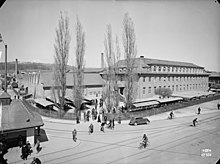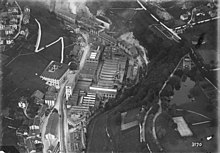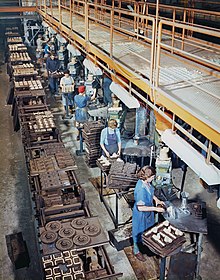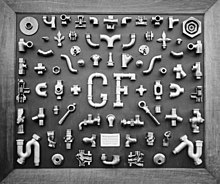Georg Fischer AG
| Georg Fischer AG
|
|
|---|---|
| legal form | Corporation |
| ISIN | CH0001752309 |
| founding | June 3, 1802 |
| Seat |
Schaffhausen , Switzerland |
| management | Andreas Müller (Chairman of the Management Board ) Andreas Koopmann ( Chairman of the Board of Directors ) |
| Number of employees | 15 027 |
| sales | 4.57 billion . CHF (2018) |
| Branch | Technology group |
| Website | www.georgfischer.com |
| As of December 31, 2018 | |
The Georg Fischer AG (GF) is a 1802 established industrial companies and is headquartered in Switzerland . It operates 140 companies in 33 countries, including 57 production sites. GF is a partner for the safe transport of liquids and gases, for lightweight cast components in vehicles and for high-precision manufacturing technology.
history


Johann Conrad Fischer (1773–1854) laid the foundation stone for today's company in 1802 with the acquisition of a mill in Schaffhausen, which he converted into a foundry. In 1827 and 1833, two steelworks followed in Austria, which Johann Conrad and son Georg (1804–1888) opened. After Johann Conrad's death in 1854, his son Georg inherited the company; Grandson Georg II (1834–1887) took over the management of the Schaffhausen company in 1856, which had been idle since the grandfather's death.
The company was named “Georg Fischer Schaffhausen” in 1861 by Georg II, and in 1864 he acquired the company from his father, began producing fittings made of malleable cast iron and introduced the first trademark: a stylized fish with the letters GF.
Health insurance for staff was launched in 1867, and one year later work began to be built and purchased in Mühlental, which is dominated by Georg Fischer . Accident insurance was part of a job at Georg Fischer from 1876, and in 1880 one of the first company restaurants in Switzerland was set up in Mühlental. The death of Georg II in 1887 forced his son Georg III (1864–1955) to drop out of studies in order to take over management of the company. Under George III, the company overcame the crisis triggered by the Vienna stock market crash ; the workforce has tripled to 550 employees over a period of nine years. As a branch of the main Schaffhausen plant, the plant in the neighboring German town of Singen am Hohentwiel was opened in 1895 in order to avoid the high tariffs imposed by Germany. To cover the increasing need for capital, Georg III converted the sole proprietorship into the « Aktiengesellschaft der Eisen- und Stahlwerke von Georg Fischer», which was initially determined by the Fischer family. At the turn of the century the company had 1,600 employees.
Overcapacities in the market led to another crisis in 1901. On the board of directors, tensions arose between Georg III and Ernst Jakob Homberger (1869–1955), who was appointed by the banks . Under pressure from the banks, Georg III was finally pushed out of the company in 1902, and Homberger took over the management, who shaped the company for the next 50 years.
From 1910 the new industrial area Ebnat was built outside the city. There were large expansion areas here, which the city made available to relieve the Mühlental. In 1918 the company acquired the estate of the former Paradies monastery in Schlatt TG . 1919 GF participated in the founding of Eisenbergwerk Gonzen AG ; the mine was closed again in 1966 and has been preserved as an industrial monument ever since. Mechanical engineering began in 1926, first with textile machines, followed by lathes from 1938. The first external sign of the change was the introduction of the new trademark in 1903, today's GF logo with the two crosses (+ GF +), which represent stylized cross fittings.
The Homberger Foundation was established in 1927 with the aim of supporting the children of GF employees in their vocational training. Britannia Iron and Steel Works Ltd. was founded under Homberger in 1933 . in Bedford and transferred to a GF subsidiary. In 1947 the company was given the name "Georg Fischer Aktiengesellschaft", which is still valid today. The " Eisenbibliothek Foundation " was founded in 1948 on the initiative of the then director Ernst Müller-Reiffer , the library itself was opened in 1952 in the partially restored Paradies monastery. Plastic fittings were first manufactured in the Singen plant in 1957, and plastics processing subsequently became a central business area. In 1964, more than half of sales were achieved abroad for the first time. The George Fischer Plastics Ltd. in Huntingdon, England, was opened in 1966 as a factory for plastic fittings. In 1968 the production of enamelled cookware and cast pans was given up.
In 1970, the company's sales exceeded the one billion Swiss franc mark for the first time ; the following years were marked by expansion. The Swiss factory in Seewis for plastic fittings was opened in 1971, in 1972 the Waeschle company in Ravensburg , Germany was acquired, and in 1974 the Group's own training center was opened on the completely renovated Paradies monastery.
Numerous restructurings took place in the 1980s, the weaving machine construction (Maschinenfabrik Rüti ) was sold to Sulzer in 1982 . Between 1987 and 1991, the activities of the Schaffhausen and Singen locations were streamlined. Singen became the location of the steel foundry, while the business with plastic pipes was concentrated in Schaffhausen. This ended the traditional steel casting in Schaffhausen's Mühlental on November 1, 1991.
The lathe was sold in 1989; In 1990 the company was completely rebuilt into a holding company . The four divisions vehicle technology, piping systems, production technology and plant engineering were created. All other activities that did not fit into the new structure were either sold or made independent.
As of November 1, 1993, the "Rail Transport Technology" division was transferred to the legally independent subsidiary Georg Fischer Verkehrstechnik AG and in November 1998 it was finally sold to Schwab Holding .
As early as 1983, 51% of Ateliers des Charmilles in Geneva were acquired and renamed Charmilles Technologies SA . The company was completely taken over by GF in 1988 and became part of the Production Technology Division. The electrical discharge machining division was expanded in 1996 by taking over the majority of shares in Agie SA in Losone, Switzerland, and brought under one roof in the newly founded Agie Charmilles Holding AG in Zug .
The Plant Construction Division became an independent company in 2000 as Coperion Holding GmbH , based in Constance . In 2004, a new corporate design was introduced and the divisions were given their current names: vehicle technology became GF Automotive (today GF Casting Solutions ), piping systems became GF Piping Systems , and production technology became GF Machine Tools (today GF Machining Solutions ). The remaining shares in Coperion were sold in 2006 and a restructuring of the Swiss locations of the GF Machine Tools division was announced - the production of the electric discharge machines is concentrated in Losone and Meyrin , part of the production is sold to the Winterthur machine factory Rieter . At the beginning of 2007, Agie Charmilles Holding AG was merged into the GF Group, with the GF Machine Tools division becoming the GF AgieCharmilles division . On January 1, 2014, GF AgieCharmilles was renamed GF Machining Solutions . The new name underlines Georg Fischer's profile as a uniform company with three divisions. On July 1, 2014, GF Machining Solutions acquired Liechti Engineering AG , thereby strengthening its expertise in the aviation industry.
At the 2017 Annual General Meeting, the shareholders opposed the management compensation model and rejected the compensation report in a consultative vote. GF then stated that it would start talks with larger shareholders and the voting rights advisors in order to present a compensation model that would be widely accepted.
In December 2018, the company announced that the iron foundries in Singen and Mettmann had been sold to Fondium BV & Co. KG , Mettmann as part of a management buy-out . They want to reduce their presence in cast iron and concentrate on light metal castings. The renaming of the two plants will not have any impact on the approximately 2,200 employees for the time being.
Divisions
- GF Piping Systems
GF Piping Systems is a provider of piping systems made of plastic and metal. The division concentrates on system solutions and components for the safe transport of water and gas in industry, utilities and building services. The product portfolio of fittings, valves, pipes, automation and connection technologies covers all applications of the water cycle.
- GF Casting Solutions
GF Casting Solutions is a development partner and manufacturer of cast and additive components for the vehicle industry, the aerospace industry, the energy segment and the global industrial and consumer goods market. The highly complex, lightweight components made of cast iron make a significant contribution to making automobiles lighter and reducing CO 2 emissions.
- GF Machining Solutions
GF Machining Solutions is a provider of electrical discharge machines, high-speed milling machines and machines for laser texturing for tool and mold construction as well as for manufacturers of precision parts. The most important customer segments include information and communication technology as well as the aerospace and automotive industries.
literature
- Adrian Knoepfli: Success with cast iron and steel: Johann Conrad Fischer (1773–1854), Georg Fischer I (1804–1888), Georg Fischer II (1834–1887), Georg Fischer III (1864–1925). 2002, ISBN 3-909059-24-4 .
- Hannes Siegrist: From a family business to a managerial company: Employees a. industrial organization using the example of d. Georg Fischer AG in Schaffhausen 1797–1930. Vandenhoeck and Ruprecht, Göttingen 1981, ISBN 3-525-35702-8 .
- Hans-Ulrich Wipf: Georg-Fischer-AG 1930–1945; a Swiss industrial company in the field of tension in Europe. Chronos, Zurich, 2001, ISBN 3-0340-0501-6 .
See also
- Iron Library (of Georg Fischer AG)
- Corporate archive of Georg Fischer AG
Web links
Individual evidence
- ↑ a b c Annual Report 2018 - Georg Fischer AG. (PDF) Retrieved May 12, 2019 .
- ↑ Media release - 140704 Media release.pdf. (PDF) In: liechti.com. Retrieved September 24, 2014 .
- ↑ Bang at a traditional Swiss company . In: Tages-Anzeiger . April 20, 2017, ISSN 1422-9994 ( tagesanzeiger.ch [accessed June 23, 2019]).
- ↑ Oliver Fiedler: Georg Fischer Casting Solutions sells the Singen plant. In: (Singener) Wochenblatt. December 6, 2018, accessed December 6, 2018 .






